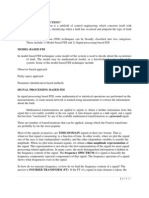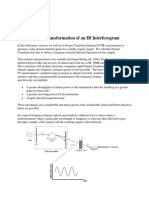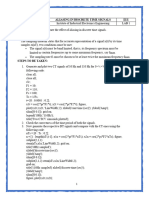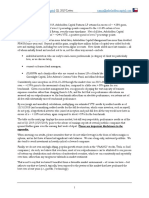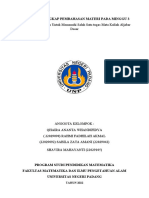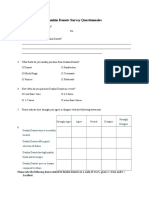Me'Scopeves Application Note #1: The FFT, Leakage, and Windowing
Me'Scopeves Application Note #1: The FFT, Leakage, and Windowing
Uploaded by
ho-faCopyright:
Available Formats
Me'Scopeves Application Note #1: The FFT, Leakage, and Windowing
Me'Scopeves Application Note #1: The FFT, Leakage, and Windowing
Uploaded by
ho-faOriginal Description:
Original Title
Copyright
Available Formats
Share this document
Did you find this document useful?
Is this content inappropriate?
Copyright:
Available Formats
Me'Scopeves Application Note #1: The FFT, Leakage, and Windowing
Me'Scopeves Application Note #1: The FFT, Leakage, and Windowing
Uploaded by
ho-faCopyright:
Available Formats
App Note #1
www.vibetech.com
4/19/2004
MEscopeVES Application Note #1
The FFT, Leakage, and Windowing
INTRODUCTION MEscopeVES features one-button commands that make it very convenient to look at signals in either the time or frequency domain. You can toggle between these domains at will without losing any signal characteristics. Transform | FFT converts a block of time-histories into equivalent frequency domain spectra. Transform | Inverse FFT converts a block of spectra back into the time domain. A more general command lets you form or augment a block of linear Fourier Spectra, Auto Spectra or Power Spectral Densities from one or more time histories. Transform | Spectrum creates a new block of spectra of various forms from time histories. Additionally, MEscopeVES has a waveform synthesizer with which you can generate a broad variety of sine, periodic, impact and random signals. File | New | Data Block synthesizes time-histories. You will use these commands to review some basic properties of the Fast Fourier Transform (FFT) and to learn how common FFT window leakage errors can be avoided. Time Domain Equation
Time Domain Windowing & Sampling. Firstly, the DFT assumes that the time domain signal is represented by N uniformly spaced samples of data, which satisfy the equation, T = N t where: T = total time of the sampled signal (in seconds) N = number of samples (block size) t = time step (increment) between samples The schematic figure above depicts the mathematics of digitally characterizing a continuous (analog) timehistory. This consists of two steps: 1) Multiply the signal by a rectangular observation window (also called a boxcar window) to limit its duration to a practical observation time. This is termed time truncation. 2) Measure the amplitude of the truncated signal at a series of equally spaced observation times. This quantizes the measurement in time. Note that the total observation time, T, of the sampled signal includes the time up to but not including sample N+1 (which may be considered as the first sample point of a subsequent observation block). (1)
Steps in his Application Note can be duplicated using any package that includes VES-300 Signal Processing.
BASIC TIME & FREQUENCY RELATIONSHIPS The FFT is an efficient algorithm for computing the Discrete Fourier Transform (DFT) of a digitally measured time domain signal such as a time-history. There are three basic formulas that govern all DFT calculations.
Page 1 of 8
App Note #1
www.vibetech.com
4/19/2004
Frequency Domain Equation Secondly, the DFT assumes that the frequency domain spectrum of the signal is represented by the mean value (DC) plus N/2 uniformly spaced complex-valued samples (magnitudes and phases), which satisfy the equation: fmax = f (N/2) where: fmax = maximum frequency of the signal (in Hz) f = frequency step (increment) between samples (also called Lines) N/2 = frequency domain block size fmax is termed the Nyquist frequency of the data. Note that a resulting spectrum has N/2 + 1 samples; DC plus N/2 frequencies. Note further that the DC value and the value at the Nyquist Frequency, fmax, contain no phase information. These Lines are real valued; all other Lines are complex-valued. Nyquist sampling Thirdly, the maximum frequency of the spectrum, fmax, is related to the time-domain sampling rate, fs, specifically: fmax = 2fs /2 where: fs = 1/t = the sample rate (samples/second) at which data is sampled. Equation (3) is a statement of Shannons sampling theorem, namely: The maximum frequency of a spectrum is one half the sampling rate of its corresponding time domain signal. Solving the frequency domain equation for f, and substituting for 2Fmax gives a fourth important relationship: f = 2fmax /N = 1/ Nt = 1/T (4) (3) (2)
SYNTHESIS OF A PERIODIC SIGNAL Lets start our study by synthesizing a periodic signal and analyzing its characteristics. The Fourier Series of a symmetric square-wave of amplitude 1 and frequency, f0, is given by:
y(t ) =
Sin[2 (2k + 1) f t ] (2k + 1) 4 1
k =0 0
(5)
Hence the first three sine waves of this series are:
1 1 y (t ) = Sin(2f 0 t ) + Sin(6f 0 t ) + Sin(2f 0 t ) 3 5
(6)
They approximate a square-wave of /4 = 0.795 amplitude with a fundamental frequency, f0, of 5 Hz. Execute: File | New | Data Block. A Synthesize Time Traces dialog (below) will open.
This final formula tells us that the frequency resolution, f, of a digital spectrum is always equal to the reciprocal of the observation time, T, of the signal snapshot. In other words, to obtain finer frequency resolution (smaller f), a signal must be sampled over a longer period of time, not at a higher sampling rate, fs.
Synthesis dialog box showing entry of 5 Hz squarewave.
Page 2 of 8
App Note #1
www.vibetech.com
4/19/2004
In the Data Block Parameters section, make the following entries: Block Size (N) = 100 Points Sample Rate (fs) = 100 Samples/Second
Note that entry of any two of these Data Block Parameters establishes the remaining four parameters. Your entries have established: T = 1 Sec T = 0.01 Sec fmax = 50.0 Hz f = 1.00 Hz Accept the default value for Starting Time = 0. Execute: File | Properties. Accept the default values in the Trigger / Averaging Parameters section: Pre-Trigger Delay = 0 Samples Number of Averages = 1 On the Sinusoidal tab at the dialogs bottom: Select Number of Frequencies = 3. Select Number of Traces = 1. Enter Frequency (Hz) values of 5, 15 and 25 Hz. Enter Magnitude values of 1, 1/3 and 1/5 g. Verify that all Phase and Damping values remain at the default 0 value. Press OK. 5 Hz square-wave approximated by harmonics 1, 3 & 5. To verify the Data Block Parameters assigned to this synthesized measurement:
A new Data Block (BLK) Window will open, displaying the 5 Hz square-wave approximated by the three sine waves just defined. Note that the amplitude (in the center of the ringing) approximates 0.795 g as anticipated. Observe that exactly five cycles of this periodic waveform are captured in the 1.00 second T duration of the window.
Data Block Properties for synthesized 5 Hz square-wave. The corresponding Data Block Properties Window will open. Verify that the tabulations agree with your prior N, T, T and Starting Time entries to Synthesize Time Traces. Press OK to close this dialog.
Page 3 of 8
App Note #1
www.vibetech.com
4/19/2004
Now lets look at the FFT spectrum of the square-wave. Execute: Transform | FFT. The signal is transformed to a complex spectrum and the Data Block Properties reflect this. The block size now reflects number of frequency Lines (N/2) as well as f and the fmax.
When T coincides exactly with N cycles of a signal being analyzed, everything works perfectly. Amplitudes and frequencies are properly identified with high precision, as we have just seen. Truncated or Aperiodic Signal Lets repeat our square-wave experiment, but with a single change. We will simply move the fundamental (f0) frequency from 5 Hz to 4 2/3 Hz, leaving all other processing parameters as they were. Execute: File | New | Data Block and make the revised entries.
FFT spectrum of synthesized 5 Hz square-wave. Note the sharp spikes at 5, 15 and 25 Hz. Use the cursor to precisely measure the amplitude and frequency at each peak. Select: Display | Cursor | Line Cursor. Select: Display | Cursor | Cursor Values. Note that the spectrum faithfully captures the 1, 1/3 and 1/5 g amplitudes synthesized for the first, third and fifth harmonics of this periodic waveform. Execute: File | Save. Save your work as 5 Hz Square.BLK and close its Window. Synthesis dialog entry for the 4 2/3 Hz square-wave. The only difference between this synthesis and the first one are the Frequency (Hz) entries to the Sinusoidal tab. LEAKAGE, A FUNDAMENTAL DFT PROBLEM In the preceding study, we synthesized three components at 5, 15 and 25 Hz using a data block with a T of 1.00 second. Each of the square-wave components went through exactly an integer number of cycles (5, 15 and 25 respectively) during 1 Sec (T) of time. As a result, each resulting spectral peak fell exactly upon an integer multiple of f (1.00 Hz). Change the frequencies to 4.666667, 14 and 23.333333 Hz (1, 3 and 5 times 42/3 respectively).
Note that the 3rd harmonic (14 Hz) remains an exact integer multiple of F and that it will have exactly 14 cycles within the 1.00 second T. However, the first and fifth harmonics are not periodic in the window.
Page 4 of 8
App Note #1
www.vibetech.com
4/19/2004
WHAT CAUSES LEAKAGE? Whenever we use the FFT on a signal that is not exactly periodic in the window, leakage will occur. It is the result of multiplying two signals together in one domain, which is equivalent to convolving their transforms in the other domain. Convolution is a process of shifting and adding together two signals, so that the resultant signal is a smeared version of the expected result. (See reference [1] for details.) In the case of a truncated sine wave, its correct spectrum was convolved with the spectrum of the rectangular sampling window, and the resultant frequency spectrum was the convolution of the spectrum of the sine wave with the spectrum of the rectangular window. Another Interpretation Another way to understand leakage is to look at what happens to a sampled signal. One of the fundamental rules of the FFT is that sampling of a signal in one domain causes repetition of it in the other domain. This phenomenon is illustrated below. The actual signal is a continuous sine wave. The finite duration captured version is truncated in the sampling window. The FFT computes the spectrum of the assumed signal, which when repeated outside of the sampling window, is no longer a continuous sine wave.
4 2/3 Hz square-wave synthesized in 1 second block. The 4 2/3 Hz synthesis produces no surprises. The waveform exhibits the same shape and peak amplitude seen in the 5 Hz case. The sole difference is that the 1.00 second window captures 4 2/3 cycles instead of 5. On the surface, this seems like a small point of differentiation. You are now qualified to be surprised! Execute: Transform | FFT.
Spectrum of synthesized 4 2/3 Hz square-wave. Clearly, the resulting FFT spectrum is disappointing. While three peaks may still be seen, the general character of the spectrum is far from intuitively obvious. There is significant amplitude at all frequencies from F to fmax, even though we know that only three discrete and wellseparated tones were used to create the signal. Note further that the magnitude of the 1X and 5X terms are less than the correct values. Only the 14 Hz cellcentered 3X term has a peak of correct magnitude. You have just been introduced to spectral leakage. Repetition of a Non-Periodic Signal. Instead of getting the FFT of the continuous sine wave (the expected result), we get the FFT of the assumed signal, which is a smeared sine wave spectrum. From this example it should be also clear that any type of signal that is completely contained within the sampling window (like a transient that damps out within the window), is also periodic in the window.
Page 5 of 8
App Note #1
www.vibetech.com
4/19/2004
REDUCING LEAKAGE If a periodic signal is truncated by the sampling window, leakage cannot be completely eliminated. However, it can be reduced significantly so that the resulting spectrum presents an accurate representation of the signal. This is accomplished by changing the shape of the capture window, which is multiplied by the time-history.
Both the Hanning and Flat Top windows are designed to optimize the FFT analysis of continuous (never transient!) signals. They do this by symmetrically tapering the leading and trailing edges of the observation to (essentially) zero. This has the effect of forcing the time-history to have the appearance of being periodic in T. While the 1 and 0 nature of the Rectangular window merely acts as a time gate, multiplying the measured (or synthesized) signal by a Hanning or Flat Top window changes the wave-shape of the signal prior to application of the FFT. Yes, applying such a window does distort the shape subjected to transformation. On balance, however, the effect is highly beneficial. FFT Filters We might view this from yet another perspective. The FFT numerically implements a bank of parallel detected filters. Each filter is of the same constant bandwidth (nominally f) and the center-frequencies are spaced f apart. In an ideal world, the transfer function of each filter would be a brick wall rectangle of width, f.
Window shapes: Rectangular, Hanning and Flat Top. MEscopeVES has three built-in capture windows for processing data: Rectangular, Hanning, and Flat Top. So far, you have used the Rectangular window, which is always used by default when an FFT is performed. The Rectangular window is the proper choice for analyzing transients that are completely captured within the windows T duration. It is also the proper choice when analyzing periodic signals using order-normalized sampling, a process by which fs is varied in proportion to the signal frequency. This is a common technique for the analysis of rotating machinery. In virtually all other circumstances, the Rectangular choice is inappropriate and the resulting spectrum will contain leakage. The Hanning window is the normal choice when analyzing broad-band random signals, cyclic signals, or a mixture of the two. It provides excellent suppression of truncation artifacts while retaining good selectivity, the ability to separate closely spaced tones or to detect a tone buried in a noisy background. The Flat Top window is specifically designed to give improved amplitude precision when measuring cyclic or narrow-band signals such as sine waves. It excels in this capacity, but is not as selective as the Hanning shape. Hence its use is application specific.
However, nature has not blessed us with such ideal filters (either physical or mathematical). Instead, the transfer function of each FFT filter is a complicated shape. That shape is, in fact, the Fourier Transform of the sample window. The FFT filter shapes using Rectangular, Hanning and Flat Top windows are presented below.
Magnitude of FFT filter transfer functions. Note that the FFT filters for any window are far broader than f, have a lobed shape and exhibit multiple zeros. Each exhibits maximum gain (sensitivity) at the center frequency, fcenter. Adjacent filter center frequencies are spaced f apart, so considerable overlap exists between filters.
Page 6 of 8
App Note #1
www.vibetech.com
4/19/2004
The Rectangular filter has the narrowest center lobe, (a desirable attribute) spanning 2 f between the adjacent zeros. Outside of the center lobe, the Rectangular window exhibits zero gain at every multiple of f. It also has the highest sidelobe amplitudes and the greatest curvature across the center lobe. These are detracting characteristics. Consider, for a moment, why this window works so well with sine tones that are periodic in the capture window. In this situation, a signal component is presented at exactly the center frequency of one of the banks filters. That filter responds enthusiastically as the component is coincident with its most sensitive frequency. More importantly, none of the other filters respond at all because this frequency corresponds to a zero gain point for all other filters. Now we can understand why a single truncated or noncentered sine excites spectral activity at all points in the spectrum, causing leakage. When the tone moves slightly (f / 2 or less) off of one filters center, it no longer coincides with the zeros of the adjacent filters. The Hanning window improves upon this situation by reducing the height of the first sidelobes and increasing the rate at which subsequent sidelobes decay in amplitude with frequency (from fcenter). The reduced sidelobe gain minimizes leakage of signal energy to inappropriate frequency locations. This comes at the expense of a broader center lobe with 4 fs between the bounding zeros, which reduces the effective resolution. The Flat Top window has an extremely wide center lobe, spanning more than 8 f. As the name implies, the top of the center lobe is extremely flat (within 0.1 %), providing accurate amplitude information even when a tone varies as much as f / 2 from fcenter. While the first sidelobes are well suppressed, the subsequent ones do not roll off with increasing frequency. They are all of nearly equal amplitude. The noise bandwidth, n, is the standard measure of a windows random noise performance. It is the bandwidth of an ideal rectangular filter that passes the same broadband power when both are subjected to white noise. n is the per Hz frequency of PSD amplitude. n
Rectangular f Hanning 1.5 f Flat Top 3.77 f Flatness % 36.24 15.12 0.11 1 Sidelobe dB -13.2 -32.1 -93.0
st
PROOF OF PERFORMANCE Lets reduce leakage in our 4 2/3 Hz square-wave spectrum by applying a more appropriate window. Start by transforming the last spectrum measured back into a time history. Execute: Transform | Inverse FFT. Now we will build a new Data Block containing three different spectra, all from the same synthesized data. These spectra will differ by the window function applied. 1. 2. Execute: Transform | Spectrum. Press Fourier Spectrum in the Calculate Spectrum dialog. Select the Rectangular window in the Spectrum Averaging dialog, then click OK. A Calculate Spectra box will open informing you that the calculation is completed. Click on OK. Click New File in the Data Block Selection dialog and then press OK. Enter a file name such as window comparison in the New File dialog and click OK.
3.
4.
5.
6.
Roll-off dB/decade -20 -60 none
Creating a new Spectrum Data Block. The new window comparison.BLK now holds the first spectrum (that using a Rectangular window) as M#1.
Page 7 of 8
App Note #1
www.vibetech.com
4/19/2004
Repeat preceding steps twice with the following small changes. In step 3 select Hanning for the first repetition and Flat Top for the second. In step 5 do not click New File. Instead, verify that window comparison.BLK is the active choice and press Add To.
This adds the spectrum made using Hanning as M#2 and the Flat Top spectrum as M#3.
4 2/3 Hz square-wave analyzed with 3 different windows. This comparison plot clearly illustrates that either the Hanning or Flat Top window will eliminate most of the leakage, making the proper 3 peak shape of the spectrum clearly evident. The Flat Top window provides the best amplitude estimates compared to the synthesis entries, as evidenced by the following table. Note that the cell-centered 14 Hz component did not contribute leakage to the 4.6667 Hz and 23.3333 Hz terms, but the converse is not true. The amplitude at 14 Hz was affected by the leakage from the other two offcenter tones.
Peak @ 5 Hz 14 Hz 23 Hz Hanning -6.95 -0.07 -6.95 Flat Top 0.00 0.00 0.00
Augmenting an existing Spectrum Data Block. Execute: File | Save. Save your work as 4.667 Hz Square.BLK and close its Window.
Rectangular -19.50 7.01 -13.85
Shift your attention to the window comparison.BLK. Certain graphic commands simplify comparing the three traces. Format | Overlay Traces allows all selected traces to be overlaid in a single plot Window. Format | Rows/Columns facilitates graphic layout of multiple plots, each with one trace. Format | Vertical Axis controls the vertical axis format and scaling Format | Horizontal Axis controls horizontal axis format and scale.
Percent Amplitude Error using 3 different windows.
REFERENCES 1. Richardson, M., Fundamentals of the Discrete Fourier Transform, Sound and Vibration Magazine, March 1978. Richardson, M., Modal Analysis Using Digital Test Systems, Seminar on Understanding Digital Control and Analysis in Vibration Test Systems, Shock and Vibration Information Center Publication, Naval Research Laboratory, Washington, D.C., May 1975.
MEscopeVES window functions comply with ISO 18431-2
2.
Page 8 of 8
You might also like
- Creating Graphics For The Channel Impulse Response in Underwater Acoustics With MATLABDocument9 pagesCreating Graphics For The Channel Impulse Response in Underwater Acoustics With MATLABLeonNo ratings yet
- Digital Spectral Analysis MATLAB® Software User GuideFrom EverandDigital Spectral Analysis MATLAB® Software User GuideNo ratings yet
- GER3620L Nov 3 09b RevDocument60 pagesGER3620L Nov 3 09b RevGTENG CPINo ratings yet
- Girth Gear WearDocument6 pagesGirth Gear Wearho-fa100% (2)
- How To Install Secret Bookcase DoorsDocument5 pagesHow To Install Secret Bookcase DoorsDouglas CristianoNo ratings yet
- The FFT, Leakage, and Windowing: Mescope Application Note 01Document12 pagesThe FFT, Leakage, and Windowing: Mescope Application Note 01BelaliaNo ratings yet
- Lab 03Document7 pagesLab 03Pitchaya Myotan EsNo ratings yet
- 752 Frequency ModulationDocument10 pages752 Frequency ModulationMiki ArsovskiNo ratings yet
- Fourier LabDocument6 pagesFourier LabAzeem IqbalNo ratings yet
- Exp#02 Analysing Biomedical Signal Using DFT and Reconstruct The Signal Using IDFTDocument6 pagesExp#02 Analysing Biomedical Signal Using DFT and Reconstruct The Signal Using IDFTMuhammad Muinul IslamNo ratings yet
- Part1 - Chapter 3 - Edited-1Document4 pagesPart1 - Chapter 3 - Edited-1Kimbeng FaithNo ratings yet
- Facultad de Ingeniería Laboratorio de Análisis de SeñalesDocument6 pagesFacultad de Ingeniería Laboratorio de Análisis de SeñalesFernando DiegoNo ratings yet
- FFT in EnglishDocument9 pagesFFT in EnglishBagus NugrohoNo ratings yet
- Appnote 38Document13 pagesAppnote 38Dungdhts TranNo ratings yet
- NVH Fallstudie Frequency AnalysisDocument5 pagesNVH Fallstudie Frequency Analysisreek_bhatNo ratings yet
- FFTs and Oscilloscopes A Practical GuideDocument8 pagesFFTs and Oscilloscopes A Practical GuidecasagrandeNo ratings yet
- Chapter 3: The Uncertainty Principle & Time-Bandwidth ProductDocument6 pagesChapter 3: The Uncertainty Principle & Time-Bandwidth ProductDeepak KumarNo ratings yet
- Proyecto 04Document6 pagesProyecto 04Scott Backster Clarck0% (1)
- What Is Fault Detection?Document25 pagesWhat Is Fault Detection?Dr-Priyadarsan ParidaNo ratings yet
- TFCLEAN: Time-Frequency Noise Suppression: TopicsDocument14 pagesTFCLEAN: Time-Frequency Noise Suppression: TopicsVijay YadavNo ratings yet
- Lab 03 F 01Document8 pagesLab 03 F 01sabi1234No ratings yet
- Bio Signal Processing - CompressedDocument74 pagesBio Signal Processing - CompressedMkl BdNo ratings yet
- Me'Scopeves Application Note #2: Waveform Integration & DifferentiationDocument8 pagesMe'Scopeves Application Note #2: Waveform Integration & Differentiationho-faNo ratings yet
- ADSP AssignmentDocument15 pagesADSP AssignmentPrabhat Ranjan TripathiNo ratings yet
- Lab 02Document8 pagesLab 02Joevane B. EscrupoloNo ratings yet
- DSP-7 (Multirate) (S)Document58 pagesDSP-7 (Multirate) (S)Jyothi JoNo ratings yet
- OFDM TutorialDocument23 pagesOFDM Tutoriallg900df5063No ratings yet
- Tapering and Other Practical Considerations: X (F) Exp IDocument6 pagesTapering and Other Practical Considerations: X (F) Exp Ichrisna27No ratings yet
- Teori Dasar SeismikDocument8 pagesTeori Dasar SeismikTumpal NainggolanNo ratings yet
- Signal Spectra: Why Is The Spectral View Useful?Document5 pagesSignal Spectra: Why Is The Spectral View Useful?ramah WartNo ratings yet
- Matlab ActivityDocument2 pagesMatlab ActivityTatsuya ShibaNo ratings yet
- Matlab Activity-1Document2 pagesMatlab Activity-1Tatsuya ShibaNo ratings yet
- VI Lect - Notes#3 Btech Vii Sem Aug Dec2022Document164 pagesVI Lect - Notes#3 Btech Vii Sem Aug Dec2022NAAZNo ratings yet
- FFT in MatlabDocument5 pagesFFT in MatlabNguyen Quoc DoanNo ratings yet
- Fourier Transformation of An IR InterferogramDocument12 pagesFourier Transformation of An IR InterferogramIvt RomeroNo ratings yet
- STFT in MatlabDocument27 pagesSTFT in MatlabNaveen Kumar Saganti50% (2)
- Fourier Theory & Practice, Part I: Theory: (HP Product Note 54600-4)Document10 pagesFourier Theory & Practice, Part I: Theory: (HP Product Note 54600-4)Cristian SpinelliNo ratings yet
- FFT For ExperimentalistsDocument24 pagesFFT For ExperimentalistsMara FelipeNo ratings yet
- DSP SamplingDocument36 pagesDSP Samplingin_visible100% (1)
- DWT PaperDocument6 pagesDWT PaperLucas WeaverNo ratings yet
- DSP LAB-Experiment 4: Ashwin Prasad-B100164EC (Batch A2) 18th September 2013Document9 pagesDSP LAB-Experiment 4: Ashwin Prasad-B100164EC (Batch A2) 18th September 2013Arun HsNo ratings yet
- Application of DFT Filter Bank To Power Frequency Harmonic MeasurementDocument5 pagesApplication of DFT Filter Bank To Power Frequency Harmonic Measurementfranchisca9999No ratings yet
- NI Tutorial 4844 en Understanding FFT and WindowingDocument11 pagesNI Tutorial 4844 en Understanding FFT and WindowingpaivensolidsnakeNo ratings yet
- Lab-10 Fourier TransformDocument3 pagesLab-10 Fourier TransformAbdullah IbrahimNo ratings yet
- Signal ProcessingDocument16 pagesSignal ProcessingSatish SirikondaNo ratings yet
- PCM SamplingDocument11 pagesPCM SamplingErRajivAmieNo ratings yet
- Damping MeasurementsDocument50 pagesDamping MeasurementsWon-young Seo100% (1)
- All Labs DSPDocument86 pagesAll Labs DSPM. Bilal Abbasi 32No ratings yet
- Lab Work 5 - Fourier Analysis of Continuous-Time SignalDocument13 pagesLab Work 5 - Fourier Analysis of Continuous-Time SignalFikry ZahidNo ratings yet
- Exp1 PDFDocument12 pagesExp1 PDFanon_435139760No ratings yet
- Chapter 4Document10 pagesChapter 4Manwinder Singh GillNo ratings yet
- Tperry Elec484-A5Document64 pagesTperry Elec484-A5AntonioPalloneNo ratings yet
- Low-Latency Convolution For Real-Time ApplicationDocument7 pagesLow-Latency Convolution For Real-Time ApplicationotringalNo ratings yet
- Spectral Analysis Lab 1Document18 pagesSpectral Analysis Lab 1ali aminNo ratings yet
- EE 306 Matlab HW2Document1 pageEE 306 Matlab HW2aaal09No ratings yet
- DSP Lab 2Document4 pagesDSP Lab 2fahadsaeed93No ratings yet
- Filter Bank: Insights into Computer Vision's Filter Bank TechniquesFrom EverandFilter Bank: Insights into Computer Vision's Filter Bank TechniquesNo ratings yet
- Digital and Kalman Filtering: An Introduction to Discrete-Time Filtering and Optimum Linear Estimation, Second EditionFrom EverandDigital and Kalman Filtering: An Introduction to Discrete-Time Filtering and Optimum Linear Estimation, Second EditionNo ratings yet
- Analysis and Design of Multicell DC/DC Converters Using Vectorized ModelsFrom EverandAnalysis and Design of Multicell DC/DC Converters Using Vectorized ModelsNo ratings yet
- Software Radio: Sampling Rate Selection, Design and SynchronizationFrom EverandSoftware Radio: Sampling Rate Selection, Design and SynchronizationNo ratings yet
- Single Channel Phase-Aware Signal Processing in Speech Communication: Theory and PracticeFrom EverandSingle Channel Phase-Aware Signal Processing in Speech Communication: Theory and PracticeNo ratings yet
- Machinery Lubrication Brochure EDocument2 pagesMachinery Lubrication Brochure Eho-faNo ratings yet
- NotesOnFluidFilmJournalBearing OverviewDocument71 pagesNotesOnFluidFilmJournalBearing OverviewbatporaNo ratings yet
- Creating Survey Periods and Printing The Survey Period ReportDocument6 pagesCreating Survey Periods and Printing The Survey Period Reportho-faNo ratings yet
- ST101 in A PDM ProgramDocument4 pagesST101 in A PDM Programho-faNo ratings yet
- Filling The GapDocument3 pagesFilling The Gapho-faNo ratings yet
- Mobility... A New Approach To Measuring Actual Forces in MachineryDocument4 pagesMobility... A New Approach To Measuring Actual Forces in Machineryho-faNo ratings yet
- DCA31 QuickGuideDocument23 pagesDCA31 QuickGuideho-fa100% (1)
- Fabreeka Am EprintDocument4 pagesFabreeka Am Eprintho-faNo ratings yet
- Lowfreq Preceng PDFDocument4 pagesLowfreq Preceng PDFho-faNo ratings yet
- Vibration ANALYSIS StandardsDocument24 pagesVibration ANALYSIS Standardsho-faNo ratings yet
- L, JKDocument8 pagesL, JKIceNo ratings yet
- Psychological Safety: The Optimal Context For Injury PreventionDocument3 pagesPsychological Safety: The Optimal Context For Injury PreventionErica A. Gallegos AriasNo ratings yet
- Introduction To City, Site& Surroundings: G R O U P H O U S I N G Architectural Thesis Site AnalysisDocument9 pagesIntroduction To City, Site& Surroundings: G R O U P H O U S I N G Architectural Thesis Site AnalysisAshish GuptaNo ratings yet
- Wind Load As Per IS875 Part 3-2015Document10 pagesWind Load As Per IS875 Part 3-2015hobuneyNo ratings yet
- Askeladden Capital Investor Letter Scars and How We Got ThemDocument23 pagesAskeladden Capital Investor Letter Scars and How We Got ThemMario Di MarcantonioNo ratings yet
- CotHL - HD (v1) (OEF) (2022-06-30)Document48 pagesCotHL - HD (v1) (OEF) (2022-06-30)empedoclesNo ratings yet
- 2021 INTI ComputingDocument19 pages2021 INTI ComputingrfefudhNo ratings yet
- HSBC Case StudyDocument3 pagesHSBC Case StudythunderNo ratings yet
- Steam Tinkrworks DL PblkitDocument8 pagesSteam Tinkrworks DL PblkitIdagoNo ratings yet
- Homeshopping - PK: The Largest Store For Online Shopping in PakistanDocument12 pagesHomeshopping - PK: The Largest Store For Online Shopping in PakistanHome PhoneNo ratings yet
- NCERT Chemistry - States of Matter - DronStudyDocument34 pagesNCERT Chemistry - States of Matter - DronStudySamEarth SamEarthNo ratings yet
- Chem InvestigatoryDocument24 pagesChem InvestigatoryHarshuNo ratings yet
- Aljabar DasarDocument13 pagesAljabar DasarSabila ZataNo ratings yet
- Black Dawn - Sands of Fear and WorderDocument26 pagesBlack Dawn - Sands of Fear and WorderJoshua KinnearNo ratings yet
- A Report On Classroom ObservationDocument6 pagesA Report On Classroom ObservationHilda Ortiz SelsoNo ratings yet
- Unit-2 Array RepresentationDocument22 pagesUnit-2 Array RepresentationNjNo ratings yet
- Reference, Sense and Denotation in English SemanticsDocument2 pagesReference, Sense and Denotation in English Semanticsomarrabeaa1234No ratings yet
- SCX500Document28 pagesSCX500nugroho.eryNo ratings yet
- Dunkin Donuts Survey QuestionnaireDocument3 pagesDunkin Donuts Survey QuestionnaireJocelyn StephanieNo ratings yet
- Yintr24447-Microled-Markets Applications and Competitive Landscape 2024-Product BrochureDocument18 pagesYintr24447-Microled-Markets Applications and Competitive Landscape 2024-Product Brochureqixuanwang22No ratings yet
- Msu Prospectus New2Document30 pagesMsu Prospectus New2ranbir888No ratings yet
- Fast Nuces Entry Test MaterialsDocument5 pagesFast Nuces Entry Test MaterialsHamna noor100% (3)
- Petition For Writ of KalikasanDocument18 pagesPetition For Writ of KalikasanJeanne Pabellena DayawonNo ratings yet
- Medical DeviceDocument13 pagesMedical DevicemashayNo ratings yet
- Lab-2: Introduction To Labview (Part-2) : 1. ObjectiveDocument13 pagesLab-2: Introduction To Labview (Part-2) : 1. ObjectiveAsad RazaNo ratings yet
- Principles of Colloid and Surface Chemistry: (Third Edition)Document90 pagesPrinciples of Colloid and Surface Chemistry: (Third Edition)Audry YuniarNo ratings yet
- Cargador de BatieraDocument30 pagesCargador de BatieraCARLO DÍAZNo ratings yet
- "A Study On Challenges Faced by Indian Banking System DuringDocument48 pages"A Study On Challenges Faced by Indian Banking System DuringPriti DuttaNo ratings yet
- Vocab TestDocument2 pagesVocab Testhồ huyền myNo ratings yet


















